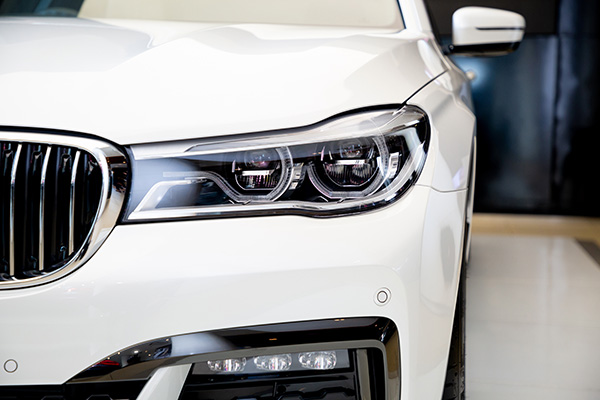
A careful test drive tells you more than hours of online research. BMWs reward attentive drivers, and the way a car steers, shifts, and idles can reveal what it needs before you buy.
Use these seven checks on your next drive so you can spot concerns early, budget realistically, and choose a car that feels as tight and confident as it should.
1. Steering Feel, Tramlining, And Highway Stability
On a straight road at 50–65 mph, the wheel should sit centered and the car should track calmly. If it wanders or follows ruts, the front control arm bushings or alignment may be tired. A sharp knock over small bumps hints at ball joints. Light nibble in the wheel points to tire cupping or balance, not always a big repair, but a cost to consider. Strong, precise on-center feel is the goal; anything vague is worth a closer look on a lift.
2. Idle Smoothness And Start-Up Rattles
Start the engine cold if possible. A brief metallic rattle can indicate timing chain guide wear on some models. Once running, the idle should be steady without shaking the seat or steering wheel. A low buzz in Drive that improves in Neutral often suggests engine mount wear rather than an engine miss. During the drive, watch for a check engine light that comes and goes, a sign of minor misfires or a vacuum leak that will need attention.
3. Transmission Behavior In Traffic And On Hills
BMW automatics should engage Drive promptly and shift cleanly with light throttle. Hesitation into gear, a flare on 2–3 or 3–4 upshifts when warm, or a small shudder during gentle acceleration points toward fluid and filter service or adaptation concerns. In manuals, a slipping clutch shows up as rising rpm without matching road speed on hills. Any thump when shifting from Park to Drive, or a clunk on and off the throttle, can also relate to worn drivetrain bushings or a tired guibo (flex rubber disc).
4. Cooling Performance At Idle And After A Short Stop
Let the car idle with the A/C on. Air should stay cold, and the temperature gauge or indicator should remain stable. A/C that turns warm at a standstill, then recovers on the move, can point to a weak electric fan or debris packed between the condenser and radiator. After a short shutdown, a sweet smell or faint hiss suggests a small coolant seep at a hose, tank, or plastic housing. These are common on aging BMWs and worth catching before they become bigger leaks.
5. Brake Feel, Noise After A Long Drive, And Pedal Consistency
In a safe area, brake hard from neighborhood speeds. The wheel should stay steady and the car should stop straight. A shake under braking can be rotor thickness variation from dragging calipers or glazed pads. After a longer drive, listen carefully when rolling to a stop. A light chirp or hot smell at one corner can mean a caliper is sticking. The pedal should feel firm and hold its height at a stop; a slow sink hints at hydraulic issues that require prompt service.
6. Suspension Noises And Rear-End Composure Over Bumps
Find a road with small, repeated bumps. A rhythmic thump from the front often traces to worn strut mounts or control arm bushings. From the rear, a hollow knock over sharp edges can relate to shock mounts or sway bar links, especially on models with sport suspension. The car should settle quickly after each bump. Excess bounce means weak dampers, which also show up as cupped tire tread and a slightly floaty feel on faster roads.
7. Electrical Clues, Battery Strength, And Warning Messages
BMWs are sensitive to voltage. On the test drive, run the blower, headlights, and rear defrost together briefly. Lights should remain steady and idle should not dip. Random messages after startup or stop-start that rarely engages can indicate a weak battery or charging issue. Test every window, camera, and parking sensor. Intermittent parking brake or stability warnings may be as simple as a wheel speed sensor, but they are signals to scan the car for stored faults before you commit.
How To Structure Your Test Drive For Clear Answers
Begin cold if you can. Listen on start-up, then drive a smooth neighborhood loop to check idle and light throttle. Move to a straight road for stability and brake tests, then add a short highway segment to expose bearing noise or shimmy that only appears with speed. Return through a few tight turns and a rough block to check bushing and mount behavior. Finish by letting the car idle for a minute with A/C on while you walk around and sniff for coolant or oil odors.
When A Concern Is A Deal Breaker, And When It Is Just Negotiation
Small items like tired tires, a weak battery, or slightly noisy pads are common and easy to price. A steady misfire, active coolant leak, slipping transmission, or heavy steering wander deserves caution.
If a car drives straight, shifts cleanly, idles smoothly, and stays cool in traffic, you likely found a good example. Use your notes to negotiate fairly, or walk away if major patterns stack up.
Turn Your Test Drive Notes Into Facts With Gil’s Garage Inc In Clifton Park, NY
If a BMW drives well but a few signs have you unsure, we can confirm the real condition with a pre-purchase inspection. Our technicians road test, scan all modules, check for leaks, measure suspension and brake wear, and provide photos and estimates so you can buy with confidence.
Schedule an evaluation with Gil’s Garage Inc in Clifton Park, NY, and make your next BMW a smart purchase.